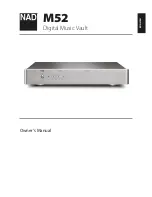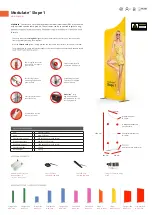
Teardrop Campers • nucamprv.com
26
nucamprv.com • Teardrop Campers
27
Labels located in various places have
weight specifications recorded for your
convenience. Examples are provided
in this manual but ultimately the
numbers recorded on your unique
trailer are what you need to go by.
Because of continuous improvement
and innovation of the manufacturing
process and available products, each
trailer may have unique weights. Each
trailer is weighed individually when it
rolls off the assembly line and the Cargo
Carrying Capacity is determined by
that weight. Should any of these labels
be de-faced, painted over or missing,
contact your dealer or nuCamp Customer
Service for replacements.
Weight Specs
STEPS TO DETERMINE CORRECT LOADS
To accurately determine correct loads on your trailer, stow all gear that you
will be taking on your camping trip and follow these steps to determine
what your trailer’s weights are:
Step 1.
Locate a public scale. Ensure that the scale reflects accurate weights.
All cargo and passengers in the tow vehicle and trailer must be consistent
when capturing weights. Always keep the rig level when weighing.
Step 2.
With the trailer attached, pull your tow vehicle onto the scales so
that all your tow vehicle wheels are on the scale and trailer wheels are off.
Record this weight as the Gross Tow Vehicle Tongue/Hitch Weight:
_____________________
Step 3.
Pull your entire rig onto the scales so that all wheels are on the
scales. Record this weight as the Gross Weight of Rig:
_____________________
Step 4.
To find the weight of your tow vehicle without the trailer’s added
hitch weight unhook your trailer from your tow vehicle and weigh just your
tow vehicle. Record this weight as the Gross Tow Vehicle Weight:
_____________________
Step 5.
The hitch weight is considered cargo for your tow vehicle and is
not load on your trailer tires. To find the weight load on your tires and axles
and determine if you are within the trailer’s GVWR and Maximum Load
Limits on tires, subtract the weight captured in Step 2 from the weight
captured in Step 3 and record the result as the Gross Trailer Weight –
Tongue/Hitch Weight:
a. If the result is less than the GVWR + Tongue/Hitch Weight recorded
on the VIN Label, and less than Maximum Load Limits on one tire
multiplied by 4 (tires) you are within acceptable load range.
b. If the result is more than the GVWR + Tongue/Hitch Weight, or
more than Maximum Load Limits on one tire multiplied by 4 (tires),
you must remove cargo and lighten your trailer.
_____________________
Step 6.
Tongue weight of your trailer and the hitch weight bearing on your
tow vehicle are one and the same. To determine tongue/hitch weight,
subtract the weight captured in Step 4 from the weight captured in Step 2.
Record the result as Tongue/Hitch Weight:
_____________________
Step 7.
To find the gross weight of your trailer, add the results of Step 5
and 6 and record it as the GVWR:
_____________________
Step 8.
To express the tongue weight as a percentage and determine if
the tongue weight is within the safe operating margin of 10-15% of gross
trailer weight, divide the result of Step 6 by the result of Step 7. Record it
as Tongue Weight Percentage:
_____________________
a. If the Tongue Weight Percentage is under 10%, move trailer cargo
to the front of the trailer. Repeat Steps 2-8 to reweigh.
b. If the Tongue Weight Percentage is over 15%, move trailer cargo to
the rear of the trailer. Repeat Steps 2-8 to reweigh.
Step 9.
To determine whether your trailer is balanced side to side you will
need to pull your trailer on the scale so that only the two wheels on the
same side of the trailer are on the scale. Record this weight as Gross Load
on One Side:
_____________________
Now subtract this weight from the result of Step 5 and record it as Gross
Load on Opposite Side:
_____________________
Total: _____________________
Compare the two numbers.
The difference between the two numbers will
tell you how much more weight is on one side versus the other. Move cargo
to the side with less weight to balance side to side and repeat this step.
LEVELING
It is important to stabilize and level your trailer when using it because:
• The refrigerator performs best when leveled.
• The shower, sink, and water systems can drain and function properly.
• Walking is easier inside when the trailer is stable and level.
• It is easier to prepare food and perform various activities.
STABILIZING & SET UP
Your travel trailer is equipped with a stabilizing system that serves to keep
the trailer from bouncing while in use. Follow these procedures when
setting up and stabilizing your travel trailer:
1. Pull into a campsite that is level and free of protruding branches and
obstacles. Your trailer should be as level as possible.
2. Set your tow vehicle park brake.
3. Block the trailer wheels with wheel chocks.
4. If equipped, remove the weight distribution bars and stow.
5. Remove the pin from the coupler and pull it back to release the
ball hitch.
6. Extend the tongue jack to lift the tongue off the hitch. The tongue
jack must be connected to 12V power to work properly.
7. Remove the safety chains, breakaway lanyard and 7-pin connector
plug. Neatly lay them over the front of the chassis.
Your electric trailer brakes are
engineered to work in synchronization
with your tow vehicle brake system and
a brake controller. Relying on your tow
vehicle or trailer brakes alone to stop the
rig may result in loss of control, serious
injury or death.
WARNING
Always level your trailer when in use.
Failure to level can cause water leaks,
refrigerator failure or other damage.
CAUTION















































